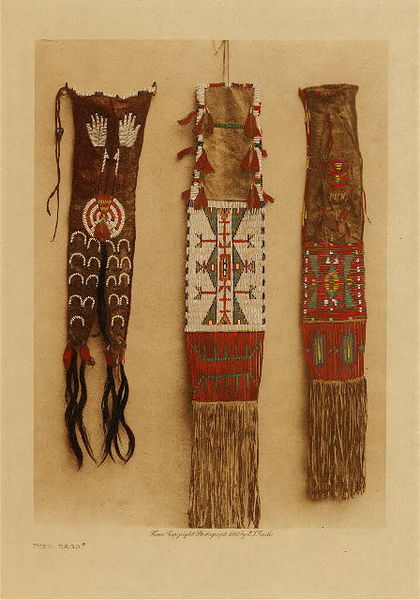Edward S. Curtis (1868-1952)
View Artist Biography
Title:
*50% OFF OPPORTUNITY* Pipe-Bags
Date:
1908
Size:
Volume, 12.5 x 9.5 inches
Medium:
Vintage Photogravure
Native American female artists across North American plains created and decorated pipe-bags. Pipe-bags was an essential part of each man’s wardrobewere and were used to carry tobacco and pipes. This original photogravure by Edward S. Curtis was taken in 1908 and then hand painted.
The decorative arts of the Lakota found expression on their deerskin garments, pipe-bags, saddle -blankets, robes, parfleches, shields, and tipis. Before the coming of traders, the designs were worked
Wholly in dyed porcupine quills, later they obtained beads, which are now used largely, and in a majority of cases the two materials are combined in a single decoration. There seem to be no fixed motif in many of their designs, each woman reading into her art whatever may be promoted by her thoughts, the same figure sometimes meaning as many different things as there are workers. In the accompanying plate are shown three tobacco-pouch pipe-bags. The middle one, a particularly elaborate and beautiful piece of work is in quills and beads; that to the right is an old specimen worked entirely of quills; while the one to the left is a waka, or sacred, pouch that has been in the family of the Ogalala chief, Slow Bull, for four generations. Its form, pattered after the human figure, is representative of a strange enemy killed in traditionary times in the midst of a buffalo herd, and the tufts of hair are emblematic of the scalp-locks taken. Four pipes, two of which appear on the side shown, represent the four generations since the pouch was originated. The circle of beadwork is symbolic of embryonic life, and the pouch is considered very efficacious during parturition. The hands represent the enemy killed by each generation, and the red striped the four winds. Slow Bull’s father told him to put on the pouch a beaded hoof for each horse he captured, but when seventeen years of age he ook one hundred and seventy horses at one time, so he has embroidered on it as many hoofprints as the pouch would accommodate. The figured margin has no significance; it was designed merely “to look pretty.” The braid of sweet-grass is for lighting the sacred pipe on special occasions.
Provenance:
Art Institute of Chicago, Ryerson & Burnham Library
The decorative arts of the Lakota found expression on their deerskin garments, pipe-bags, saddle -blankets, robes, parfleches, shields, and tipis. Before the coming of traders, the designs were worked
Wholly in dyed porcupine quills, later they obtained beads, which are now used largely, and in a majority of cases the two materials are combined in a single decoration. There seem to be no fixed motif in many of their designs, each woman reading into her art whatever may be promoted by her thoughts, the same figure sometimes meaning as many different things as there are workers. In the accompanying plate are shown three tobacco-pouch pipe-bags. The middle one, a particularly elaborate and beautiful piece of work is in quills and beads; that to the right is an old specimen worked entirely of quills; while the one to the left is a waka, or sacred, pouch that has been in the family of the Ogalala chief, Slow Bull, for four generations. Its form, pattered after the human figure, is representative of a strange enemy killed in traditionary times in the midst of a buffalo herd, and the tufts of hair are emblematic of the scalp-locks taken. Four pipes, two of which appear on the side shown, represent the four generations since the pouch was originated. The circle of beadwork is symbolic of embryonic life, and the pouch is considered very efficacious during parturition. The hands represent the enemy killed by each generation, and the red striped the four winds. Slow Bull’s father told him to put on the pouch a beaded hoof for each horse he captured, but when seventeen years of age he ook one hundred and seventy horses at one time, so he has embroidered on it as many hoofprints as the pouch would accommodate. The figured margin has no significance; it was designed merely “to look pretty.” The braid of sweet-grass is for lighting the sacred pipe on special occasions.
Provenance:
Art Institute of Chicago, Ryerson & Burnham Library
